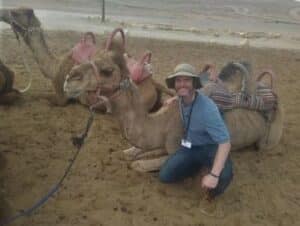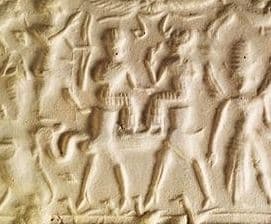The Bible describes domesticated camels as early as the time of Abraham in Genesis. Yet, many scholars claim that camels were not domesticated in the land of Canaan/Israel until the tenth century BC, or around the time of King David or Solomon. Is the Bible incorrect? Are the scholars wrong about the timing of camel domestication in the land of Israel? In fact, neither of these conclusions is necessary. A closer look at the biblical data shows that it does not contradict the scholars’ conclusions.
Camels in Genesis
 The earliest references to domesticated camels in the Bible occur in the Genesis accounts of Abraham and his household. It is important to remember, however, that Abraham was not from the land of Canaan. He obeyed God and left his homeland in Mesopotamia and moved to Canaan, where he lived as a pastoral nomad, traveling about with his flocks and herds. When we look at all of the references to camels in Genesis, we find that every one of them relates to the possessions of Abraham and his household (Isaac, Ishmael, Jacob, etc.). The references are as follows:
The earliest references to domesticated camels in the Bible occur in the Genesis accounts of Abraham and his household. It is important to remember, however, that Abraham was not from the land of Canaan. He obeyed God and left his homeland in Mesopotamia and moved to Canaan, where he lived as a pastoral nomad, traveling about with his flocks and herds. When we look at all of the references to camels in Genesis, we find that every one of them relates to the possessions of Abraham and his household (Isaac, Ishmael, Jacob, etc.). The references are as follows:
- Abram receives camels from the king of Egypt (Genesis 12:16)
- Abraham’s servant has camels when he travels to Mesopotamia to find a bride for Isaac, (Genesis 24)
- Jacob acquires camels while working for Laban in Mesopotamia (Genesis 30:42)
- Jacob brings camels back from Laban in Mesopotamia, gifting some to his brother Esau (Genesis 31:17, 34; 32:7, 15).
- Ishmael’s family has camels (37:25).
Note that all of these animals came from outside of the land of Canaan, and none of them remained there. As Genesis ends, Jacob and his household leave Canaan for Egypt, bringing all of their animals with them, (Genesis 47:1). Esau and his household had already left Canaan with all of their livestock to dwell further south in Seir. (Genesis 36:6-8). Ishmael and his descendants had likewise left Canaan to settle in a land east of Egypt (Genesis 25:18). Thus, Genesis does not describe domesticated camels among the peoples of Canaan. It describes them in foreign lands, only passing through Canaan for a short time and leaving without a trace.
The rest of the early Old Testament
After Genesis, the story remains the same. In Exodus, the king of Egypt has camels (Exodus 9:3), but the Israelites do not. Even those camels their ancestors had brought with them seem to have either been seized by the Egyptians or perhaps to have died out without successful breeding (since the Edomites are also never again mentioned as having such animals, it is quite possible that Abraham’s household never bred them, and may not have owned animals of both sexes with which to do so).
The law listed camels among the animals that Israelites cannot eat (Leviticus 11:4, Deuteronomy 14:7), but this hardly implies their owning the animals. These passages list numerous wild animals. There is no indication here of domesticated animals in Canaan. Indeed, none of the five books of Moses ever describes the peoples in or around Canaan as having camels, and the Book of Joshua never mentions the animals at all!
In the Book of Judges, camels are exclusively associated with “the Midianites, the Amalekites, and the sons of the East” (Judges 6:7, 7:12, 8:21,26), foreign raiders who come into the land for only a short time. Even by the time of Kings Saul and David, these animals are primarily associated with “the Geshurites and the Girzites and the Amalekites” who inhabited a land outside Israel “as far as Egypt” (1 Samuel 27:8, see also 1 Samuel 15:3, 30:17).
It is true that some Israelites bring David food on camels (1 Chronicles 12:40), though it is interesting to note that David put an Ishmaelite in charge of the camels (1 Chronicles 27:30), which may imply that Israelites were not yet accustomed to caring for such animals. This fits with the current scholarly view that domesticated camels were new to Israel at this time. Even afterward, during the reign of Solomon, the text mentions them only as a part of the wealth of the foreign Queen of Sheba who traveled from outside the land (1 Kings 10:2, 2 Chronicles 9:1).
Indeed, throughout the rest of the Old Testament, camels are primarily referenced in relation to foreign powers like Ethiopia (2 Chronicles 14:15), Babylon (Isaiah 30:6), and Persia (Isaiah 27:7). Any careful reading of the Old Testament would never leave one with the impression of early, widespread use of domesticated camels in the land of Canaan/Israel. The biblical data perfectly matches our current findings.
Camels in archaeology
Okay, but is the Bible wrong to suggest that camels were domesticated anywhere as far back as the time of Abraham? No, not at all! Archaeology and ancient records affirm the presence of these beasts of burden in the eastern lands where the Bible places them. To give just a few examples:
 A plaque from the Sumerian city of Eshnunna depicts a rider on a camel and a grain distribution list from the 17th-century BC lists camels among livestock needing food supplies.1 Clay figures of camels pulling carts, pastoral poetry about milking camels for dairy, and an image on an 18th-century BC cylinder seal depicting men riding a two-humped (or Bactrian) camel all strongly indicate that such camels were domesticated that far back in history, including in Mesopotamia from whence Abraham came and Jacob later acquired the beasts from Laban.2
A plaque from the Sumerian city of Eshnunna depicts a rider on a camel and a grain distribution list from the 17th-century BC lists camels among livestock needing food supplies.1 Clay figures of camels pulling carts, pastoral poetry about milking camels for dairy, and an image on an 18th-century BC cylinder seal depicting men riding a two-humped (or Bactrian) camel all strongly indicate that such camels were domesticated that far back in history, including in Mesopotamia from whence Abraham came and Jacob later acquired the beasts from Laban.2
Thus, again, a proper reading of the biblical accounts fully corresponds to what archeology and history tell us about the timing and locations of the domestication of camels. Despite what some internet critics claim, there is no argument against the Bible here. Genesis has no anachronism related to the use of domesticated camels.
References
| 1↑ | Mark W. Chavalas, Biblical Views: Did Abraham Ride a Camel? (Biblical Archeology Review 44:6, November/December 2018) 64 https://www.baslibrary.org/biblical-archaeology-review/44/6/11 |
|---|---|
| 2↑ | Randall Price, Zondervan Handbook of Biblical Archeology (Zondervan, 2017) 79-80 (picture of the cylinder seal on page 78) |





